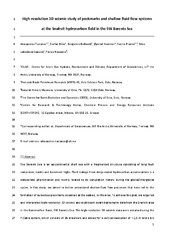| dc.contributor.author | Tasianas, Alexandros | |
| dc.contributor.author | Bünz, Stefan | |
| dc.contributor.author | Bellwald, Benjamin | |
| dc.contributor.author | Hammer, Øyvind | |
| dc.contributor.author | Planke, Sverre | |
| dc.contributor.author | Lebedeva-Ivanova, Nina | |
| dc.contributor.author | Krassakis, Pavlos | |
| dc.date.accessioned | 2018-08-20T13:55:53Z | |
| dc.date.available | 2018-08-20T13:55:53Z | |
| dc.date.issued | 2018-06-21 | |
| dc.description.abstract | The Barents Sea is an epicontinental shelf sea with a fragmented structure consisting of long fault complexes, basins and basement highs. Fluid leakage from deep-seated hydrocarbon accumulations is a widespread phenomenon and mostly related to its denudation history during the glacial/interglacial cycles. In this study, we aimed to better understand shallow fluid flow processes that have led to the formation of numerous pockmarks observed at the seabed, in this area. To achieve this goal, we acquired and interpreted high-resolution 3D seismic and multibeam swath bathymetry data from the Snøhvit area in the Hammerfest Basin, SW Barents Sea. The high-resolution 3D seismic data were obtained using the P-Cable system, which consists of 14 streamers and allows for a vertical resolution of ~1.5 m and a bin size of 6.25 × 6.25 m to be obtained. The frequency bandwidth of this type of acquisition configuration is approximately 50–300 Hz. Seismic surfaces and volume attributes, such as variance and amplitude, have been used to identify potential fluid accumulations and fluid flow pathways. Several small fluid accumulations occur at the Upper Regional Unconformity separating the glacial and pre-glacial sedimentary formations. Together, these subsurface structures and fluid accumulations control the presence of pockmarks in the Snøhvit study area. Two different types of pockmarks occur at the seabed: a few pockmarks with elliptical shape, up to a few hundred meters wide and with depths up to 12 m, and numerous circular, small, “unit pockmarks” that are only up to 20 m wide and up to 1 m deep. Both types of pockmarks are found within glacial ploughmarks, suggesting that they likely formed during deglaciation or afterwards. Some of the larger normal pockmarks show columnar leakage zones beneath them. Pressure and temperature conditions were favourable for the formation of gas hydrates. During deglaciation, gases may have been released from dissociating gas hydrates prolonging the period over which active seepage occurred. At present, there is no evidence from the 3D seismic data of active gas seepage in the Snøhvit area. Low sedimentation rates or the influence of strong deep ocean currents may explain why these pockmarks can still be identified on the contemporary seabed. | en_US |
| dc.description | Accepted manuscript version. Published version available at <a href=https://doi.org/10.1016/j.margeo.2018.06.012> https://doi.org/10.1016/j.margeo.2018.06.012</a>. Accepted manuscript version, licensed <a href=http://creativecommons.org/licenses/by-nc-nd/4.0/> CC BY-NC-ND 4.0.</a> | en_US |
| dc.identifier.citation | Tasianas, A., Bünz, S., Bellwald, B., Hammer, Ø., Planke, S., Lebedeva-Ivanova, N. & Krassakis, P. (2018). High-resolution 3D seismic study of pockmarks and shallow fluid flow systems at the Snøhvit hydrocarbon field in the SW Barents Sea. Marine Geology, 403, 247-261. https://doi.org/10.1016/j.margeo.2018.06.012 | en_US |
| dc.identifier.cristinID | FRIDAID 1594647 | |
| dc.identifier.doi | 10.1016/j.margeo.2018.06.012 | |
| dc.identifier.issn | 0025-3227 | |
| dc.identifier.issn | 1872-6151 | |
| dc.identifier.uri | https://hdl.handle.net/10037/13489 | |
| dc.language.iso | eng | en_US |
| dc.publisher | Elsevier | en_US |
| dc.relation.journal | Marine Geology | |
| dc.relation.projectID | info:eu-repo/grantAgreement/RCN/SFF/223259/Norway/Centre for Arctic Gas Hydrate, Environment and Climate/CAGE/ | en_US |
| dc.relation.projectID | info:eu-repo/grantAgreement/EC/FP7-ENVIRONMENT/265847/EU/Sub-seabed CO2 Storage: Impact on Marine Ecosystems/ECO2/ | en_US |
| dc.rights.accessRights | openAccess | en_US |
| dc.subject | VDP::Matematikk og Naturvitenskap: 400::Geofag: 450::Marin geologi: 466 | en_US |
| dc.subject | VDP::Mathematics and natural science: 400::Geosciences: 450::Marine geology: 466 | en_US |
| dc.subject | Fluid flow | en_US |
| dc.subject | Pockmarks | en_US |
| dc.subject | Ploughmarks | en_US |
| dc.subject | Barents Sea | en_US |
| dc.subject | P-Cable | en_US |
| dc.title | High-resolution 3D seismic study of pockmarks and shallow fluid flow systems at the Snøhvit hydrocarbon field in the SW Barents Sea | en_US |
| dc.type | Journal article | en_US |
| dc.type | Tidsskriftartikkel | en_US |
| dc.type | Peer reviewed | en_US |


 English
English norsk
norsk